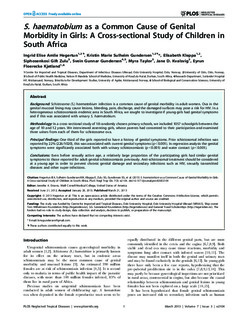| dc.contributor.author | Hegertun, Ingrid Elise Amelie | |
| dc.contributor.author | Gundersen, Kristin Marie Sulheim | |
| dc.contributor.author | Kleppa, Elisabeth | |
| dc.contributor.author | Zulu, Siphosenkosi Gift | |
| dc.contributor.author | Gundersen, Svein Gunnar | |
| dc.contributor.author | Taylor, Myra | |
| dc.contributor.author | Kvalsvik, Jane D | |
| dc.contributor.author | Kjetland, Eyrun Floerecke | |
| dc.date.accessioned | 2013-07-19T11:07:37Z | |
| dc.date.available | 2013-07-19T11:07:37Z | |
| dc.date.issued | 2013 | |
| dc.identifier.citation | Hegertun, I.E.A., Gundersen, K.M.S., Kleppa, E., Zulu, S.G., Gundersen, S.G., Taylor, M., . . . Kjetland, E.F. (2013). S-haematobium as a common cause of genital morbidity in girls: A cross-sectional study of children in South Africa. Plos Neglected Tropical Diseases, 7(3). doi: 10.1371/journal.pntd.0002104 | no_NO |
| dc.identifier.uri | http://hdl.handle.net/11250/135312 | |
| dc.description | Published version of an article from the journal: Plos Neglected Tropical Diseases. Also available from PloS: http://dx.doi.org/10.1371/journal.pntd.0002104
Open Access | no_NO |
| dc.description.abstract | Background: Schistosoma (S.) haematobium infection is a common cause of genital morbidity in adult women. Ova in the genital mucosal lining may cause lesions, bleeding, pain, discharge, and the damaged surfaces may pose a risk for HIV. In a heterogeneous schistosomiasis endemic area in South Africa, we sought to investigate if young girls had genital symptoms and if this was associated with urinary S. haematobium. Methodology: In a cross-sectional study of 18 randomly chosen primary schools, we included 1057 schoolgirls between the age of 10 and 12 years. We interviewed assenting girls, whose parents had consented to their participation and examined three urines from each of them for schistosome ova. Principal findings: One third of the girls reported to have a history of genital symptoms. Prior schistosomal infection was reported by 22% (226/1020), this was associated with current genital symptoms (p<0.001). In regression analysis the genital symptoms were significantly associated both with urinary schistosomiasis (p<0.001) and water contact (p<0.001). Conclusions: Even before sexually active age, a relatively large proportion of the participating girls had similar genital symptoms to those reported for adult genital schistosomiasis previously. Anti-schistosomal treatment should be considered at a young age in order to prevent chronic genital damage and secondary infections such as HIV, sexually transmitted diseases and other super-infections. | no_NO |
| dc.language.iso | eng | no_NO |
| dc.publisher | PLOS | no_NO |
| dc.title | S-haematobium as a common cause of genital morbidity in girls: A cross-sectional study of children in South Africa | no_NO |
| dc.type | Journal article | no_NO |
| dc.type | Peer reviewed | no_NO |
| dc.subject.nsi | VDP::Medical disciplines: 700::Clinical medical disciplines: 750::Tropical medicine: 761 | no_NO |
| dc.source.pagenumber | 8 p. | no_NO |
| dc.source.volume | 7 | no_NO |
| dc.source.journal | PLoS Neglected Tropical Diseases | no_NO |
| dc.source.issue | 3 | no_NO |
| dc.identifier.doi | 10.1371/journal.pntd.0002104 | |
